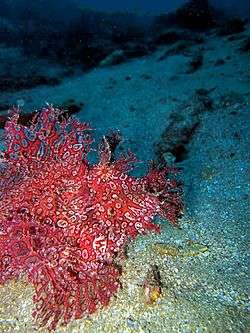Rhinopias frondosa
Rhinopias frondosa, the weed fish, or popeyed scorpionfish, is a benthic marine fish which belongs to the family Scorpaenidae or also known as the Scorpionfishes family.
| Rhinopias frondosa | |
|---|---|
| Scientific classification | |
| Kingdom: | Animalia |
| Phylum: | Chordata |
| Class: | Actinopterygii |
| Order: | Scorpaeniformes |
| Family: | Scorpaenidae |
| Genus: | Rhinopias |
| Species: | R. frondosa |
| Binomial name | |
| Rhinopias frondosa (Günther, 1892) | |
Description
The weedy scorpionfish has a highly compressed body, can reach a maximum length of 23 cm, and can vary considerably in color as well as appendages depending on its environment. Specimens found in rocky, algae rich waters are covered in weed-like appendages, whereas specimens found in deeper soft-bottomed waters with soft corals and sponges have fewer appendages.[2] Color can range vastly from dark red and purple to yellow and lavender. The variations differ so vastly that the specimens are often misidentified as between this species and two related species, Rhinopias aphanes and Rhinopias eschmeyeri. Indeed, some have argued Rhinopias eschmeyeri is a morphological variant of Rhinopias frondosa rather than a separate species. However, a 2006 study by Motomura and Johnson[3] confirmed R. eschmeyeri's existence and distinguished it from other members of the genus Rhinopias.
Distribution

The weedy scorpionfish lives in the Indian Ocean and Western Pacific Ocean, from Japan to Australia and from South Africa to the Caroline Islands. They are found in depths ranging from 13 to 90 meters.[2]
Feeding and behaviour
Like most Scorpaenidae, weedy scorpionfish are mostly nocturnal ambush hunters, using their camouflage to prey on unsuspecting fish and invertebrates. They rarely swim, but rather move along the bottom propelling themselves with their fins.[4]
In aquarium
The weedy scorpionfish has no commercial value for fisheries, but commands a high price in the aquarium trade. Although they can be found in the U.S. and Europe, they are mostly exported to Japan where they fetch a very high price. Rhinopias are highly sought after by aquarists who collect rare and unusual species.
References
- Motomura, H. & Matsuura, K. 2016. Rhinopias frondosa . The IUCN Red List of Threatened Species 2016: e.T69800391A69801052. https://dx.doi.org/10.2305/IUCN.UK.2016-3.RLTS.T69800391A69801052.en. Downloaded on 21 February 2020.
- Froese, Rainer and Pauly, Daniel, eds. (2008). "Rhinopias frondosa" in FishBase. January 2008 version.
- Motomura, Hitoyuki and Johnson, Jeffrey W., Validity of the Poorly Known Scorpionfish, Rhinopias eschmeyeri, with Redescriptions of R. frondosa and R aphanes, Copeia, V. 2006, No. 3 (September 15, 2006), pp. 500-515.
- Aquarium Fish
- "Rhinopias frondosa". Integrated Taxonomic Information System. Retrieved 10 January 2008.
- Froese, Rainer and Pauly, Daniel, eds. (2008). "Rhinopias frondosa" in FishBase. January 2008 version.
- http://www.advancedaquarist.com/issues/may2003/Fish.htm
External links
- Photos of Rhinopias frondosa on Sealife Collection
| Wikimedia Commons has media related to Rhinopias frondosa. |
